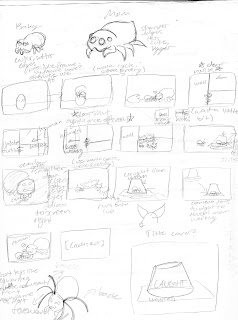What did I do this semester?
 Raccoon
Raccoon
 Our first Illustrator project was to follow a tutorial to create a raccoon, and then make the raccoon our own by adding various different decorations and accents. Then, we incorporated our raccoon into a postcard. This took a couple weeks to complete since learning Illustrator takes a while, and designing a post card can take a lot of time and effort. Sometimes when I was using certain pathfinder tools, Illustrator just wouldn't cooperate, and I would have to find some other way around. Along the way I learned how to use a bunch of different Illustrator tools, such as path finder tools and warp effects. My peers told me that they really liked my post card, and that it was really cute. Eventually, though, I had to change the background because when it came back from being printed it was too light and it was hard to see some of the other things on the card. Overall I'm really proud of the work I did on my raccoon, and it's one of my favorite projects
Our first Illustrator project was to follow a tutorial to create a raccoon, and then make the raccoon our own by adding various different decorations and accents. Then, we incorporated our raccoon into a postcard. This took a couple weeks to complete since learning Illustrator takes a while, and designing a post card can take a lot of time and effort. Sometimes when I was using certain pathfinder tools, Illustrator just wouldn't cooperate, and I would have to find some other way around. Along the way I learned how to use a bunch of different Illustrator tools, such as path finder tools and warp effects. My peers told me that they really liked my post card, and that it was really cute. Eventually, though, I had to change the background because when it came back from being printed it was too light and it was hard to see some of the other things on the card. Overall I'm really proud of the work I did on my raccoon, and it's one of my favorite projects
 Vector Portait Challenge
Vector Portait Challenge
After we had completed our self portrait vectors, we were told to choose another person or animal that we liked, and then we had to create a vector portrait of whatever we chose. I chose a shiba inu, because they're one of my favorite dog breeds. This took my a couple days since by then I had figured out how to use Illustrator, and it was also a small project. One of my biggest challenges was getting all of the "polygons" lined up so there weren't any see-through spots on the dog. Along the way I learned how to create "low-poly" pictures in Illustrator. My friends told me that they thought it was super cute, and when I put it on another art website it became pretty popular for a little bit. I had to change some of the "polygons" since they weren't shaped like try polygons if you looked close enough, and that was bothering me. This is probably one of my best works in graphic design this year, and I'm really proud of it.How did I use my time in class?
In class I really tried to maximize the amount of time I had in class, since there was so much to do with certain projects. I would often stay past the bell just to finish up whatever I was working on. If I finished a project early, we often had options for extra credit, so I would work on those projects. Outside of class I managed to get Illustrator at home and I really like messing around with Illustrator at home.
What are my strengths and weaknesses?
Strengths
I think that overall I'm really good at getting to work on my projects and finishing on time, and if I don't finish it on time, then I work hard to get it done as quickly as possible. I also feel like I learn quickly, and if you give me something new to do then I'll have no trouble picking it up.
Weaknesses
I often have a hard time coming up with inspiration. Almost all of my projects use the same or similar color scheme, and I feel like I could expand my horizons a little bit.
Summary
What did I love most about the semester?
I really loved just getting to use Illustrator more than I did last year. Last year I barely even got to learn how to use Illustrator, but now I know how to use it effectively.
What would I change?
I would probably change the amount of tutorials we had to do. Our teacher didn't really teach us anything, but she had us look at tutorials instead. I feel like if we had more time of our teacher actually teaching us, then our class might have done even better this semester.
Biggest take-away from the semester?
I learned a lot about project management this semester. I usually get really distracted when working on projects in other classes, but recently I've found that I've been able to just sit down and work better.
My goal for next semester.
My biggest goal is to be able to expand my design horizons. As I previously mentioned, most of my projects involve the same color schemes, and I'd like to change that.
Final thoughts.
I just feel like I've been really productive this semester. I'm super proud of everything I've done, and I've learned a lot along the way.































